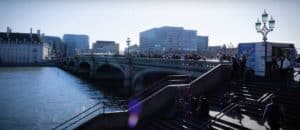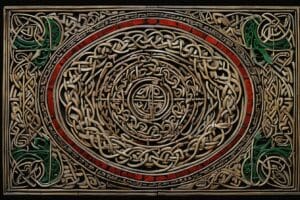Three of the Best City Breaks in Italy
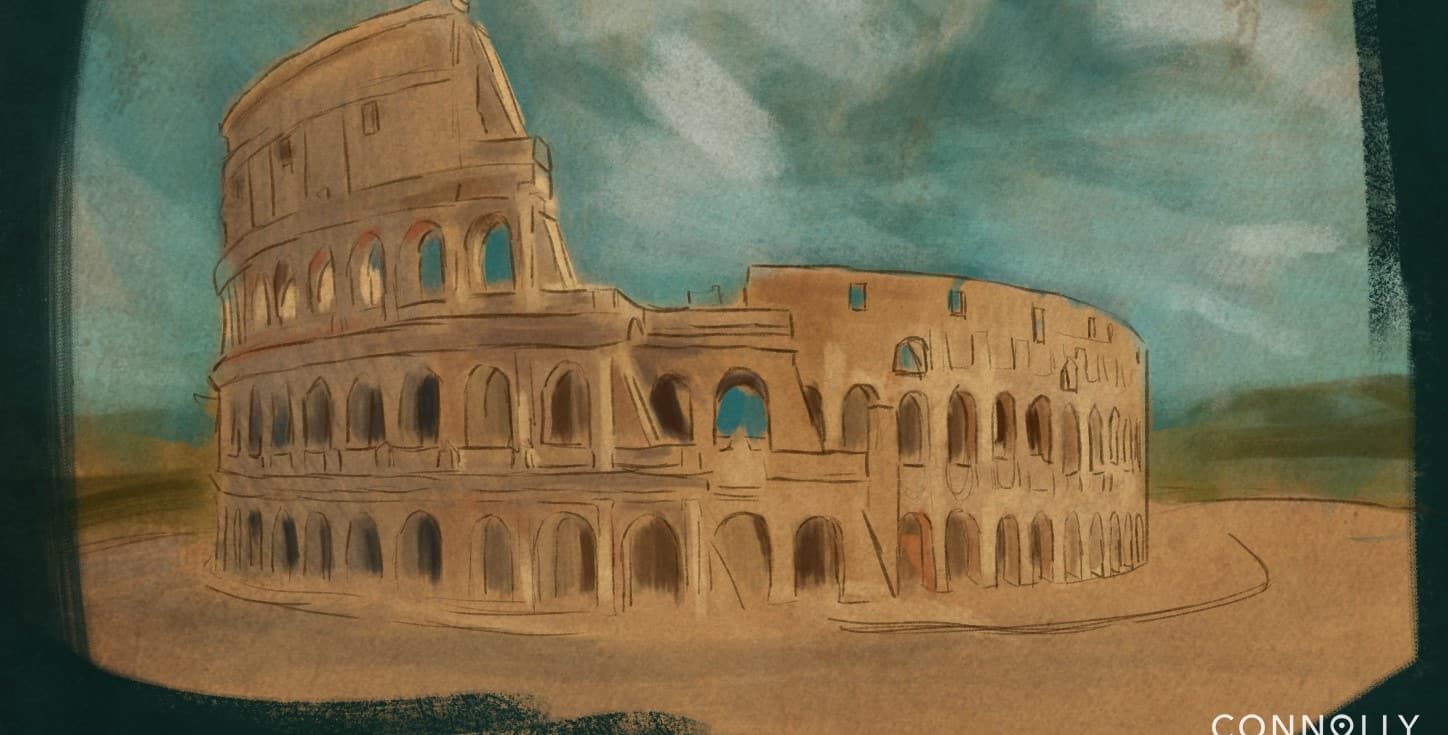
Updated On: November 08, 2023 by Ciaran Connolly
It is no surprise that Italy features the most impressive city breaks in Europe. It is one of the most visited countries in Europe, given the stunning green rolling hills of Tuscany and the old architecture of its amazing cities.
Italy is known for its delicious food, famous art scene, and pleasant climate, which attracts excited tourists worldwide. For many, travelling to one of Italy’s top cities is the only way to understand how authentically hospitable the country’s culture is.
Choosing which Italian cities to include on the schedule can be difficult if there is a plan for a trip to Italy. Perhaps one of the famous cities, like Rome, Florence, or Venice, has the best choice for the visitor’s heart.
Alternatively, perhaps the visitor would prefer to find some lesser-known jewels, like Perugia or Bergamo. Whether they want to learn about the most stunning or the greatest cuisine cities in Italy
Florence
The Etruscans laid the foundation for Florence between the sixth and seventh century B.C. This civilisation originated in Asia Minor and eventually relocated to the Tuscan region. The Etruscans decided to build their settlement where Fiesole is today on a slope a few kilometres away from Florence. It was more protected due to Florence’s location at the foot of the Apennine Mountains. Fiesole served as Florence’s sole source of support at this time.
Rome crushed the Etruscan civilisation in 395 B.C. The Romans built Florentia, a town, over the remains of the Etruscan settlement in the years that followed.
Due to its agricultural resources and advantageous location on the Via Cassia, Florence gained greater power during the Middle Ages than its neighbour Fiesole, which the Romans renamed Faesulae. The Lombards dominated Florence in the sixth century.
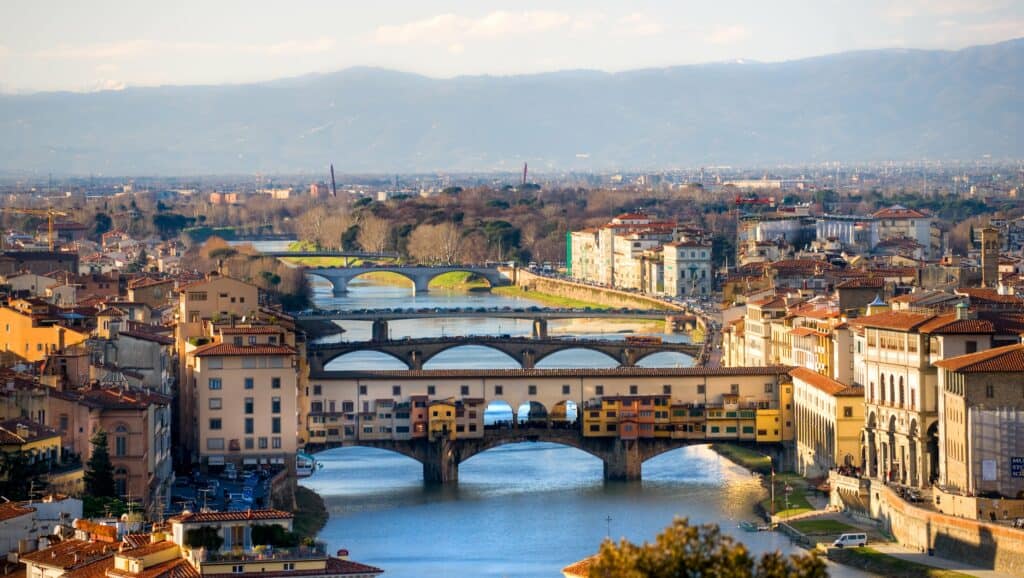
In 1406, Florence took control of Pisa and rose to maritime power. Most wealthy business people invested a portion of their fortune in constructing cathedrals and chapels to assure their eternal salvation. Additionally, they converted their homes into gorgeous palazzos.
In 1865, Florence took over Turin as the nation’s capital. Six years later, when the French forces withdrew and the region was incorporated into the newly established monarchy, it was moved to Rome.
Due to a boom in tourism, business, and industrial development, Florence’s population doubled over the nineteenth century and tripled during the twentieth.
The Arno River flooded a portion of Florence’s old centre in 1966, killing 34 people and seriously harming the city’s cultural legacy. To salvage as many damaged works of art as they could, thousands of volunteers from all around the world came to Florence.
These advocates are called “Angels of Mud” by Florentines (Angeli del fango). This love, support, and devotion for the city show how highly Florence is recognised worldwide.
Best Time to Visit Florence
Avoid travelling to Florence during the warmest months. Another justification for doing so is that Florence experiences its busiest tourist seasons in July and August when crowds of tourists are seen exploring the city.
- Winter in Florence: The typical daily temperature is between 2°C and 12°C between December and February, but at night the temperature drops; therefore, it is advisable to bring a heavy winter coat.
- Summer in Florence: The year’s hottest months saw Florence reach temperatures of over 35°C. Most of Florence’s residents go on vacation in July and August to escape the terrible heat, as is common in many Mediterranean cities.
Top Attractions in Florence
Whether you’re visiting the city to try the authentic Italian food, admire the ancient architecture, take the perfect selfies with awesome backgrounds, or even learn about the Italian history, Florence will definitely satisfy you.
1) Piazza del Duomo
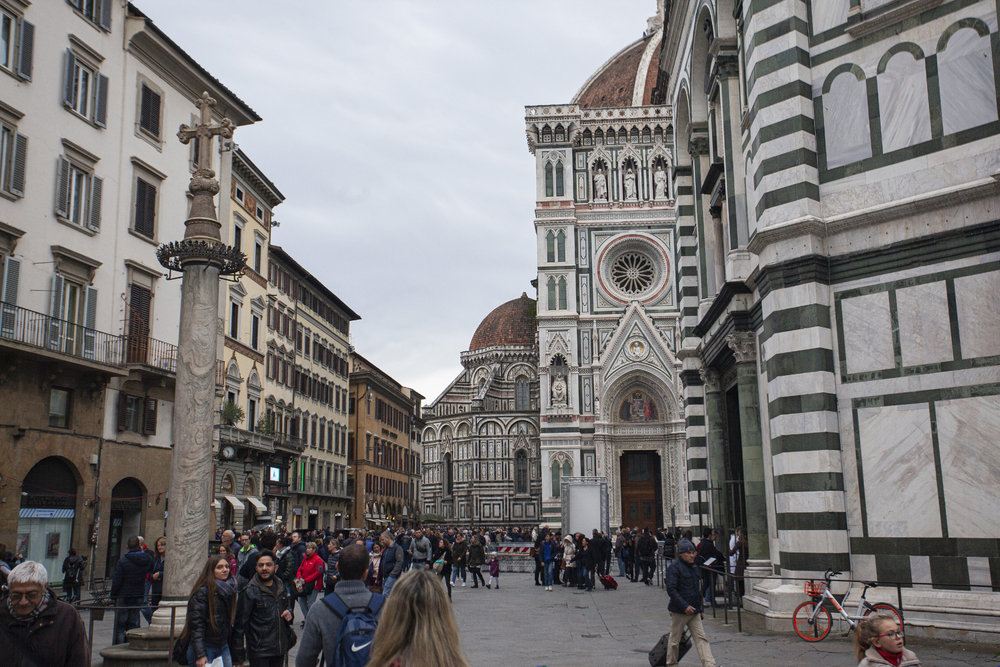
When visiting Florence, the Piazza del Duomo (Cathedral Square) must be the first and last place you go. Along with the Ponte Vecchio, the Piazza is home to the city’s Cathedral, the Campanile di Giotto, and the Battistero di San Giovanni, which comprise Florence’s most recognisable attractions.
The Piazza del Duomo is unquestionably the city’s religious and spiritual centre, with the Piazza Della Signoria representing Florence’s civic life. At the point where Via dei Calzaioli meets Piazza del Duomo, There is one of the most peculiar elements in the Piazza.
The Loggia del Bigallo, one of Florence’s earliest brotherhoods that provided shelter for abandoned and orphaned children, was established here in the fourteenth century for the Compagnia della Misericordia (Company of Mercy).
East of the cathedral stands the Museo dell’Opera del Duomo. The ancient statues that initially adorned the Piazza del Duomo are among the fascinating pieces of art found in this museum.
2) Florence Cathedral
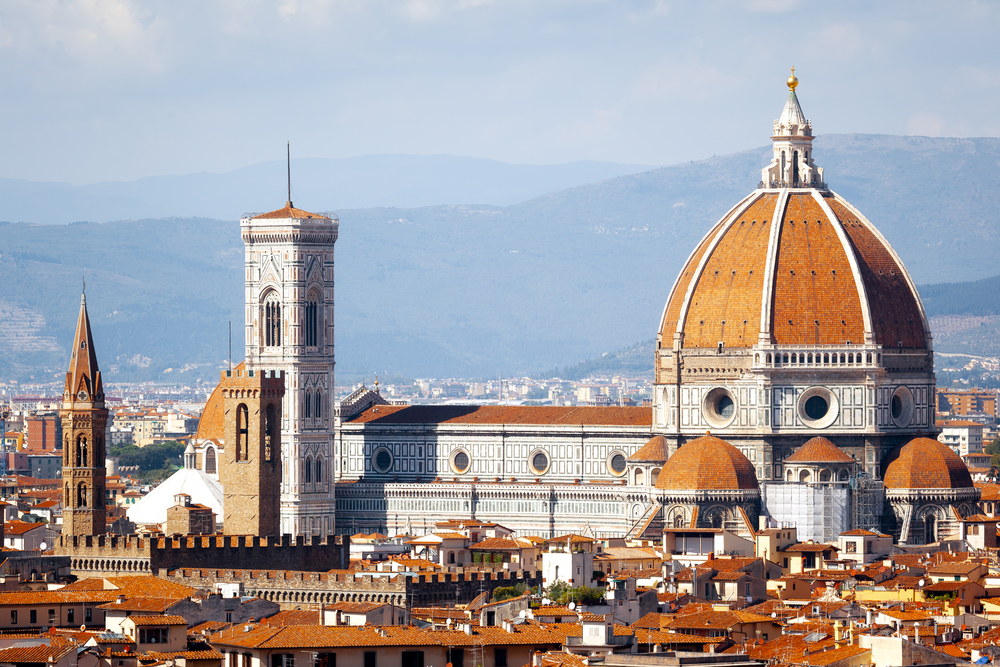
The city’s layout is dominated by Il Duomo di Firenze (Florence Cathedral), with its massive dome and lofty Campanile. The Battistero di San Giovanni (Florence Baptistery) in the Piazza del Duomo is close to both structures. Officially, the Cathedral is known as Cattedrale di Santa Maria del Fiore.
More than two centuries after the cathedrals of adjacent cities like Pisa and Lucca were erected, work on the Cathedral’s building began in 1296. The temple was not finished until 1368, 72 years later. Arnolfo di Cambio designed the Florence Cathedral.
The church is one of the most prominent Christian temples in the world based on its size. Its transverse aisle is 300 feet (90 metres) long, 525 feet (160 metres) long, and 141 feet (43 metres) wide. Over 328 feet (100 metres) tall is the dome.
The temple’s dome was built by the famous Italian designer and architect Filippo Brunelleschi more than a century after the Cathedral was finished. It stands 114 metres (45 metres) tall. The most important project for the architect required more than 14 years to complete. Brunelleschi is buried in a crypt accessible by a short staircase next to the main entrance.
Federico Zuccari and Giorgio Vasari adorned the dome’s interior. The multiple scenes depicting the Last Judgment were painted between 1568 and 1579. We have never seen a painting as impressive as this one.
The exhilaration is evident as the visitor ascends to the dome’s summit. Visitors will need a bit of courage to climb the 463 completely different steps that divide the highest point of the dome from the ground floor. The hardest part of the ascent is the final stretch, which features incredibly small and dimly lit tunnels. We recommend climbing the Campanile de Giotto if the visitor wants to take in the same breathtaking views of the city but would instead climb something more manageable.
3) Pisa
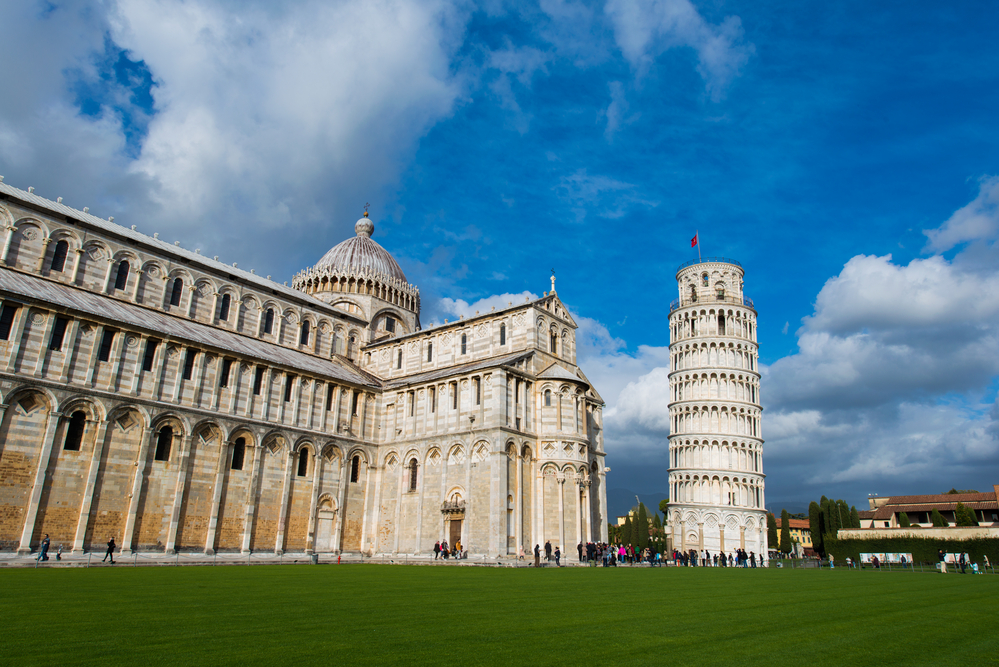
Galileo Galilei was a well-known astronomer and physicist born and raised in Pisa, a city proud of its past and historical landmarks. The town also provides visitors with all the amenities they need for an enjoyable stay.
Monuments abound in Pisa, most of which were constructed using the city’s unique Romanesque architecture. The Baptistery and the Duomo are the best-known sights. Together with the Leaning Tower of Pisa, these two majestic buildings constitute an outstanding combination.
The Bell Tower of Pisa, one of Italy’s most famous structures and bell towers, has come to represent the city. The building process started in 1173 and took 177 years to finish. The Campanile gained notoriety for its unintentional tilt while it was being built.
Florence is about 52 miles (85 kilometres) away from Pisa. It is one of Italy’s most popular tourist destinations; however, it is so tiny.
4) Piazza della Signoria
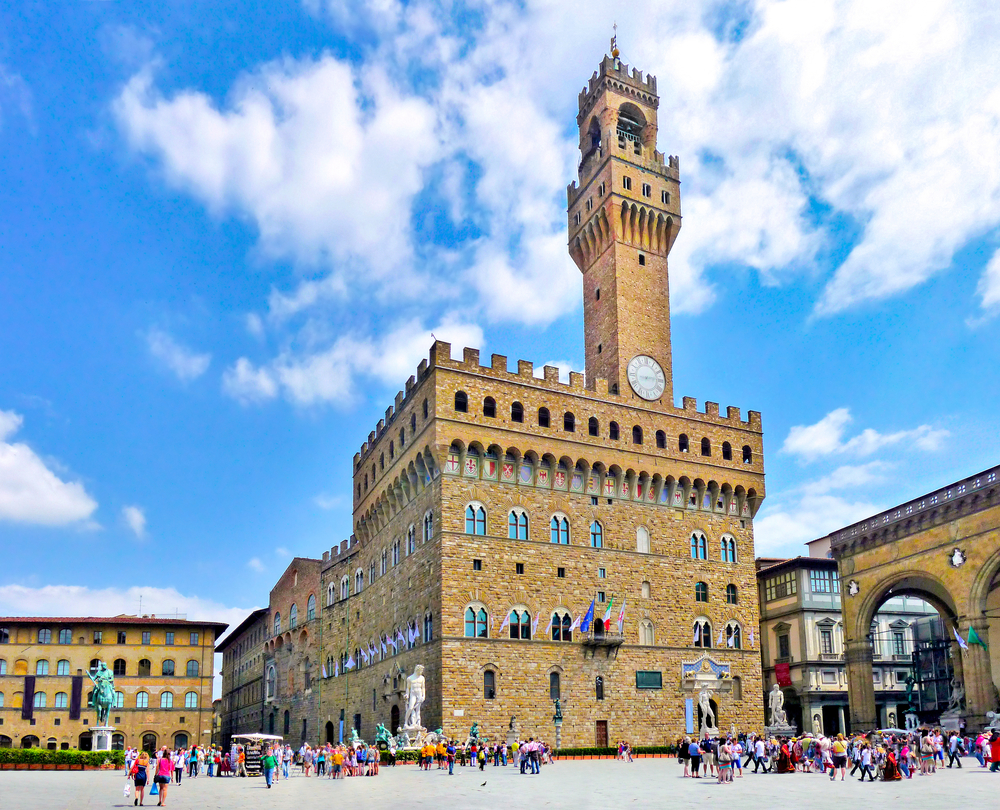
Florence’s central square is called Piazza della Signoria (Signoria Square). It is about halfway between the Arno River and the Piazza del Duomo. The Piazza della Signoria is not only Florence’s most beautiful plaza but also its liveliest. Locals and visitors gather to listen to the street performers that utilise this area as their stage throughout the year, especially on the hottest nights.
The area housed hot baths from the Roman Empire, but they were abandoned at the start of the Middle Ages, and over time, artists began to occupy the space. In its present shape, the Piazza della Signoria dates to the thirteenth century. Because it was paved at the end of the thirteenth century, Florence has regarded it as its civic and political centre.
Monuments of the Piazza della Signoria:
- Palazzo Vecchio: The Palazzo Vecchio is the most popular structure in the square (Old Palace). Visitors will find two sculptures of Adam and Eve and copies of Michelangelo’s David and Hercules and Caucus at the palace’s entryway.
- Neptune Fountain: The artist Bartolomeo Ammannati and his students constructed the Neptune Fountain. Although Florence residents initially did not appreciate it, it is today considered one of the Piazza’s most beautiful landmarks.
- Loggia della Signoria: Another name for this structure is Loggia dei Lanzi. A few sculptures, including the Kidnapping of the Sabine Women and Perseus with the Head of Medusa, can be found in this tiny outdoor museum.
It is undoubtedly one of Florence’s most lovely spots to unwind while surrounded by magnificent art pieces.
5) Uffizi Gallery
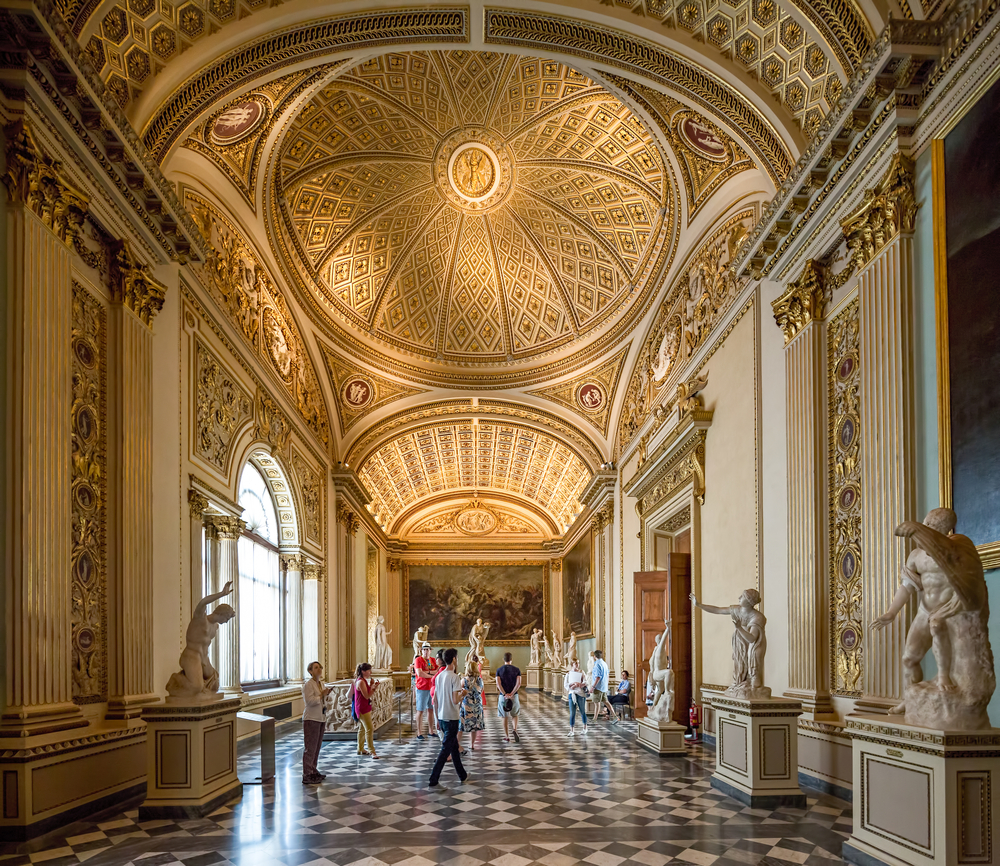
The Uffizi Gallery is home to one of the world’s most impressive art collections. Along with artwork and statues, it includes Greek and Roman pieces. The museum arrangement makes it quite simple to visit without getting lost because the numerous halls are organised chronologically.
The best-known section of the museum features artwork by notable artists from the Italian Renaissance era, including Botticelli, Leonardo da Vinci, Michelangelo, Raphael, and Titian.
Cosimo I de Medici ordered the structure in 1560. It was meant to replace Florence’s judicial and administrative buildings, the Palazzo Vecchio. It took until 1581 to complete the building, and that same year, Cosimo’s son established a private collection of paintings and sculptures made out of the many works of art owned by the Medici family.
The Uffizi Gallery contains hundreds of breathtaking works of art, but the following are the most remarkable pieces that should not be missed:
- Adoration of the Magi (Leonardo da Vinci, 1481–the painting is unfinished)
- The Birth of Venus (Sandro Botticelli, 1484)
- Venus of Urbino (Titian, 1484)
- Annunciation (Leonardo da Vinci)
- Madonna del cardellino (Raphael, 1506)
6) Galleria dell’Accademia
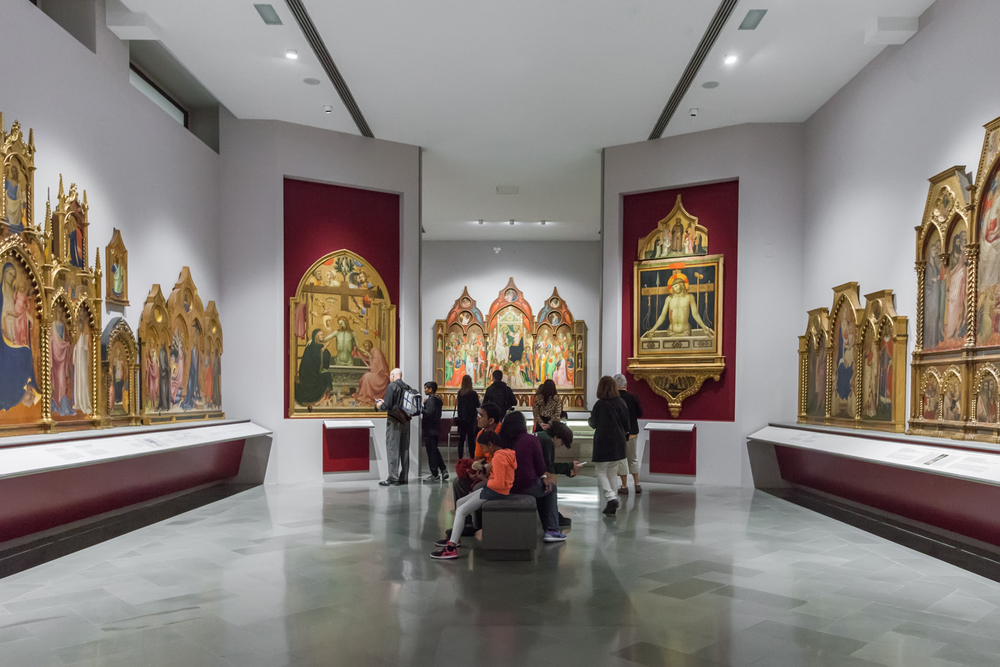
After the Uffizi Gallery, the Accademia Gallery (Galleria dell’Accademia) receives the second-highest number of visitors in Florence. To provide fine art students with resources to study, the museum opened its doors in 1784.
Michelangelo’s masterwork, David, is kept in the Galleria dell’Accademia, which has gained international recognition. This 5.17-metre tall sculpture made of white marble depicts David just before his battle with Goliath. The statue was created in the Opera del Duomo’s workshop between 1501 and 1504. It was relocated to the Ponte Vecchio’s entrance in Piazza della Signoria when it was finished.
It was put inside the Accademia in 1873. The Accademia Gallery also houses a sizable collection of religious paintings and more magnificent sculptures by various painters. A recent addition to the museum is a permanent collection of vintage musical instruments.
7) Basilica di Santa Croce
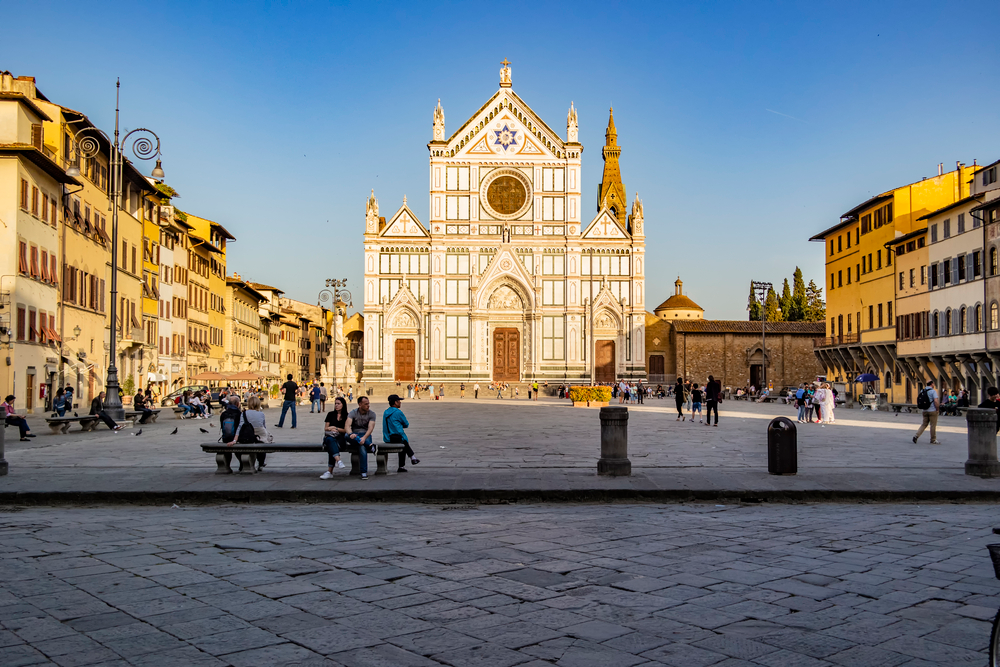
The world’s largest Franciscan church is the Basilica di Santa Croce. It is Florence’s second-largest temple, trailing only the Cathedral in size at 377 feet (115 metres) long and 124 feet (38 metres) wide.
On the exact spot where a tiny chapel had already been erected to remember Saint Francis of Assisi’s passing, the church was built in 1294. The main Dominican church, Santa Maria Novella, was disregarded once the Basilica’s construction was finished.
Even though Santa Maria Novella’s interior is more spectacular and features exposed wooden beams, the sculptures and paintings that adorn the church’s walls are of great worth. Numerous frescoes by notable artists, including Giotto, Brunelleschi, and Donatello, can be found in the chapels of the Basilica. In addition to being crowded with street performers daily, Santa Croce square hosts events all year round.
Because many illustrious Italians lay there in peace, the Temple of the Italian Glories is another name for the Basilica of the Holy Cross (Santa Croce). Nearly 300 tombs from the fourteenth to the eighteenth centuries are housed in its mausoleum. The most renowned individuals interred in Santa Croce include Michelangelo, Machiavelli, Lorenzo Ghiberti, and Galileo Galilei.
8) Piazzale Michelangelo
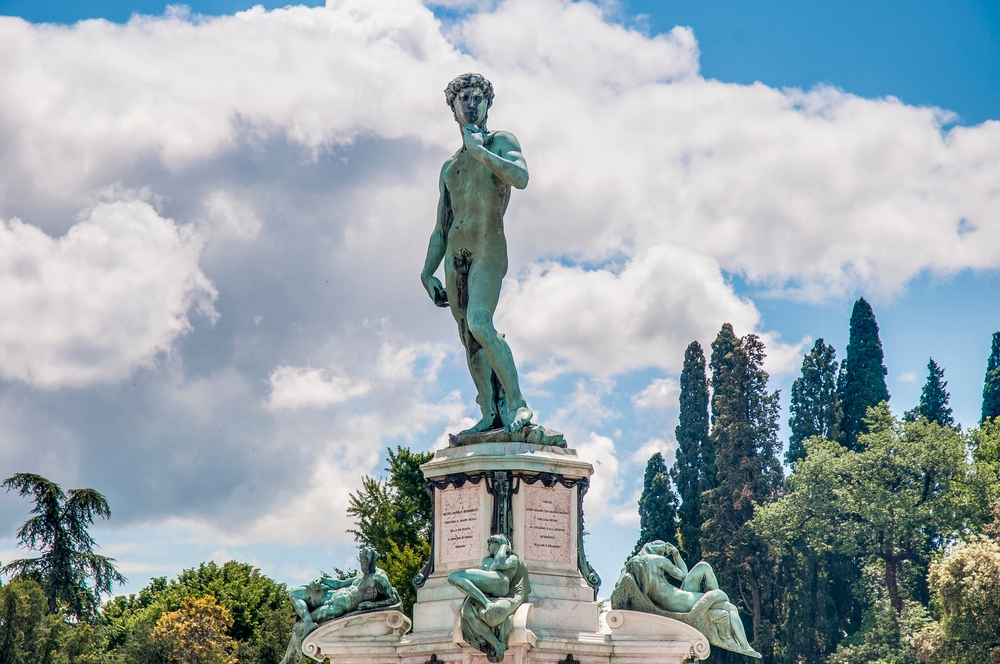
The Piazzale Michelangelo has one of Florence’s outstanding panoramic views, allowing visitors to enjoy the entire city’s beauty. A bronze replica of Michelangelo’s David can be found in the spacious Piazza. Additionally, there are many eateries and coffee shops where visitors can relax and enjoy the scenery.
Visitors may also buy tasty Italian ice cream or snacks from any of the concession stands in the square if they do not want to spend much money.
9) Boboli Gardens
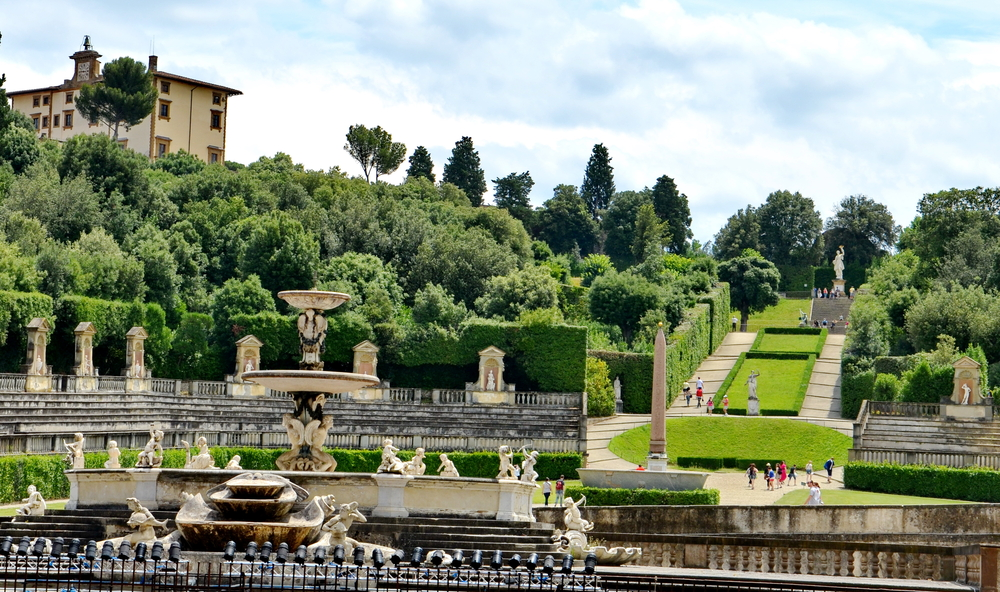
The Palazzo Pitti’s backyard conceals the Boboli Gardens. These are Florence’s largest green spaces, covering approximately 45,000 square metres.
When the Medici family acquired the Palazzo Pitti in 1550, the gardens originally only extended from the palace to the Forte di Belvedere. The green space was later expanded to the city’s southeast during the seventeenth century.
In 1766, the gardens were accessible to the public. Numerous white marble statues, fountains, pergolas, caves, and a small lake are all parts of the gardens. The historic amphitheatre is, in our opinion, the most lovely park area. An Egyptian obelisk removed from the Medici Villa in Rome is in the centre.
Best Restaurants in Florence
People come from around the world to Florence to try the amazing Italian dishes and drinks—especially the renowned wine. Here is a list of the top Italian restaurants in Florence to have the perfect experience:
1) L’Angolo del Mare
Many in the know claim that L’Angolo del Mare, a tiny eatery on the outskirts of Florence in the northeast, dishes up some of the most excellent fish and shellfish in town. The restaurant’s owners, Mirco and Carmelo, once operated a location along the Tuscan coast.
They continue to source their seafood daily from regional vendors. The limited menu included dishes like seared tuna with soy, an incredible lobster tagliolini, spaghetti with clams and salty bottarga, and excellent entire sea bass baked in a salt crust.
The daily catch determines what specials are available. A delicious champagne-strawberry tiramisu is served for dessert. While perusing the menu, order a glass of dry Franciacorta fizz, then pick from the compact but thoughtful list of reasonably priced, primarily white wines from Italy and other countries.
Carmelo is in charge of the front of the home, and he and his small staff are happy to offer advice.
2) Osteria dell’Enoteca
Osteria dell’Enoteca specialises in serving seasonal Tuscan cuisine with a contemporary twist in a modern setting within the framework of an old Oltrarno townhouse.
Pitti Gola e Cantina, a fantastic local wine bar, and this location are owned by the same person. In the summer, dishes like gazpacho topped with burrata cheese, potato soup, and spicy octopus are expected.
In the winter, dishes like pappardelle with venison sauce and braised wild pig are anticipated. Order a T-bone from one of the several breeds available, including the highly sought-after (and pricey) Fassona from Piedmont and Chianina from Tuscany.
3) Zeb
In the San Niccolo neighbourhood, Zeb is a little, stylish diner-style restaurant that serves delectable classic cuisine in a modern setting. Giuseppina and Alberto, a mother-and-son duo, prepare, serve, and pour wine from two long counters with high stools across a small area.
The serving counter is stocked with the day’s meals, while the walls are lined with wine shelves. Depending on the products on the market, the menu is altered daily. However, The visitor can expect fresh pasta dishes like pappardelle with wild boar sauce or plump cappellacci loaded with ricotta and fresh truffles.
Among the options for the main course are stuffed roast turkey, eggplant parmigiana, and pork ribs with dried apricots and prunes. Then there are the delectable sweets, which include cheesecake and chocolate cake.
Top-Rated Hotels in Florence
Staying in Florence usually feels like a live fairy tale. However, to get this feeling you want to make sure to choose carefully where to stay. Since there are multiple options with different prices and conditions, we would like to recommend some of the best hotels in Florence.
1) TSH Florence Lavagnini
TSH Florence Lavagnini is a hotel in Florence featuring a rooftop pool and city views. It is 400 metres from Fortezza da Basso and 15 minutes on foot from Santa Maria del Fiore Cathedral.
Visitors to the lodging have access to a breakfast buffet, a gourmet restaurant, a Bistrot, and an on-site bakery where they may have focaccia. There are also vegetarian and vegan options. TSH Florence Lavagnini provides meeting spaces, high-speed WiFi, a panoramic fitness centre, and on-site shops. On-site bike rentals are also offered.
Strozzi Palace is 1.5 km distant, and Santa Maria Novella is a 12-minute walk from the hub. The property is located 6 kilometres from Florence Airport.
2) C-Hotels Ambasciatori
In Florence’s historic centre, near Santa Maria Novella Church and ten minutes walk from the Cathedral, lies the upscale hotel known as The Ambasciatori. Air conditioning and free WiFi are provided in its soundproofed rooms.
Every morning, a breakfast buffet is offered at the San Pietro. A cocktail, drink, or snack at Sweet Bar is ideal. The hotel is a 10-minute stroll from the city’s business district and the Fortezza da Basso exhibition centre. Independent reviews reveal that visitors enjoy this area of Florence the most.
3) Hotel Machiavelli Palace
Within a 14th-century monastery, 300 metres from Santa Maria Novella Train Station, is where the Machiavelli Palace is located. WiFi is free throughout, and its seasonal roof garden has stunning views of Florence’s ancient centre.
Machiavelli’s rooms have a traditional Florentine design. Some feature balconies with views of the Cathedral, while others have ceilings with exposed wooden beams. A continental breakfast buffet is open daily, and room service is available upon request. The seasonally open roof garden has a bar.
4) Nilhotel
The 4-star Nilhotel, which provides free parking and WiFi throughout, is located 10 minutes from Florence’s airport and downtown. Every morning, a variety of American breakfast is offered. The large rooms of Nilhotel are tastefully decorated with light colours and wood furniture. Some rooms additionally feature a balcony.
Italian and foreign cuisines are served at the upscale restaurant Davide. There are also wines and foods from Tuscany. There are two laptops in the lobby with free internet access, a fully furnished terrace that ensures complete relaxation, and a well-equipped fitness centre among the amenities.
Venice
In 421, Venezia was established. Following their expulsion by the Ostrogoths and Lombards, the Veneti sought refuge in these marshes at the mouth of the River Po, eventually establishing the city of Venice.
The Byzantine Empire’s general, Flavius Belisarius, seized Venice in the sixth century. Venice joined the Exarchate of Ravenna while protected by the Eastern Roman Empire. Later in 829, Saint Mark the Evangelist’s relics were taken from Alexandria in Egypt and brought to Venice. San Marco would become the city’s patron saint, and St. Mark’s Basilica would house his relics.
Venetian dominance grew as a result of the trade in the following goods: timber, fish from Dalmatia, iron from the Alpes, spices and silk from Alexandria and Constantinople, as well as the transportation of enslaved people.
The Venice City Council and mayor Riccardo Selvatico adopted a resolution on 19 April 1893, calling for the establishment a national art exhibition on the Lagoon. On 30 April 1895, the inaugural Venice Biennale officially opened. It is currently one of the most well-known art shows in the entire world.
The city’s environs underwent significant urban growth following World War II. Many people who had previously resided in the city’s centre then moved to Mestre, particularly in the 1970s and following the 1966 floods.
Best Time to Visit Venice
Italy’s northern region includes Venice, near the Alps. If the plan is to visit the Serenissima at a particular time of year, the climate varies significantly from season to season. The streets of Venice are fortunately tiny and offer shade because it can get pretty hot during the day.
The summer is unquestionably the best time to visit Venice if The visitor has the option because the days are long, the climate is delightful, and they can take advantage of the Adriatic Sea.
A morning trip to Lido di Venezia, a large sandbar adjacent to Venice where visitors may sunbathe and swim in the Adriatic Sea at a pleasant temperature throughout July, August, and September, is advised if they plan to spend more than a weekend in Venice.
The typical temperature in winter is below 10°C (50°F). There is much snowfall, and it can get rather cold. If you’re more interested in the Venice Carnival, you should plan your trip to Venice in the winter.
Top Attractions in Venice
If you need a destination to celebrate your anniversary, try the one and only gondola, or explore the unique Italian beauty, look no further! Venice has a variety of refreshing, romantic, thrilling vacation programmes that you can choose from.
1) The Grand Canal of Venice
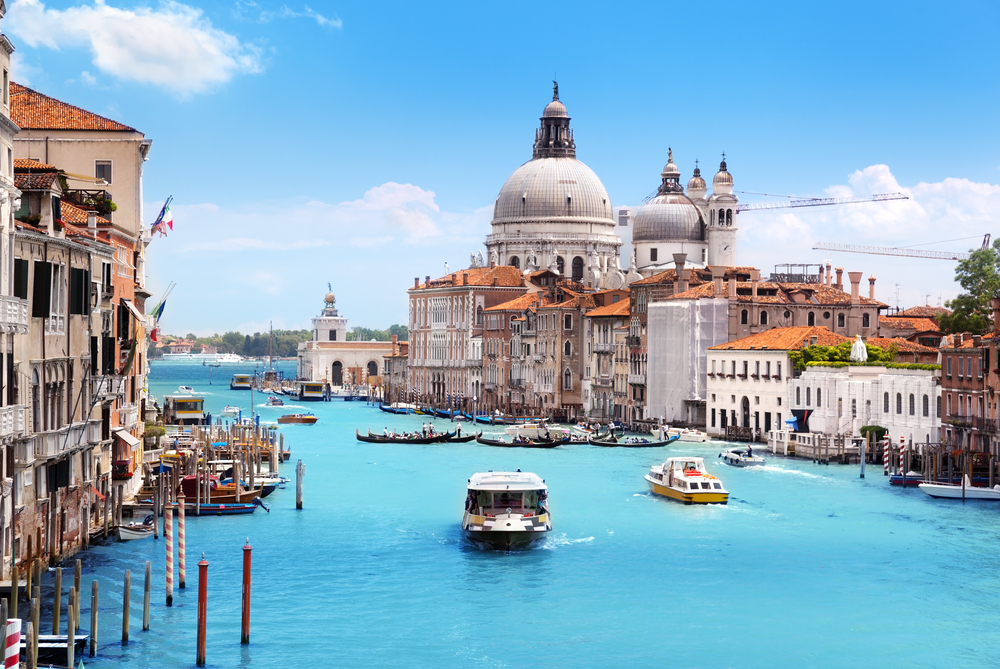
The lovely canals that wind through every part of the city, like streets, define Venice the most. The Grand Canal, which divides Venice in two and is four kilometres long, is the longest and most significant of all.
Tourists and locals can cross the Grand Canal using various methods, such as a water bus or a “Traghetto”. The Grand Canal is traversed by the water buses, which make stops along both waterway banks. It is a beautiful and affordable way to take in the stunning structures and palazzos on either side of the city’s primary thoroughfare.
2) Piazza San Marco
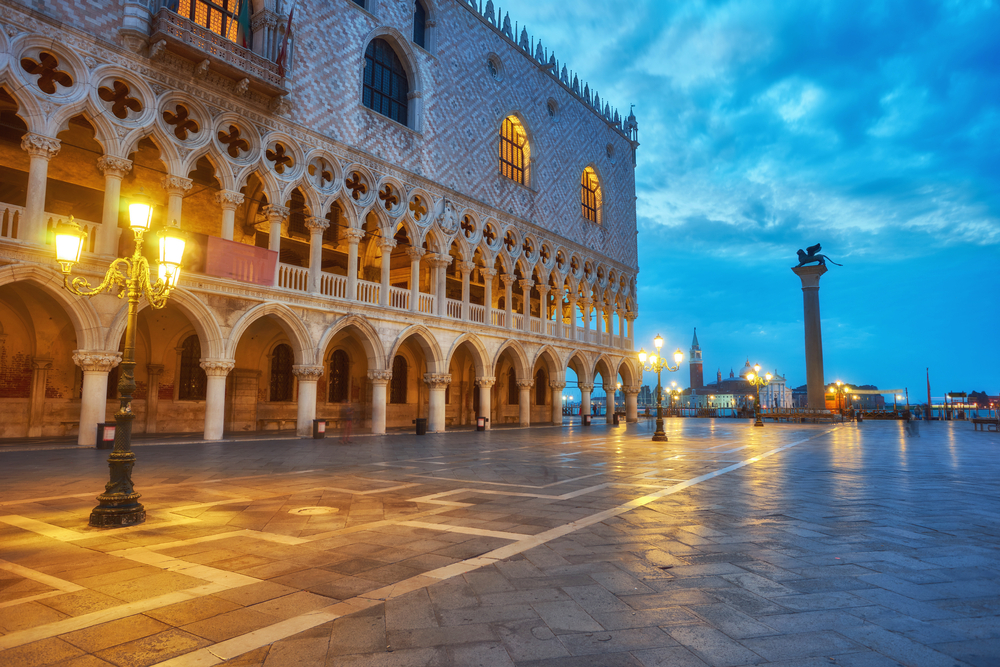
Venice’s centre is Piazza San Marco. It is the only “piazza” in Venice because the other squares are referred to as “piazzales” or “campos,” and it is 590 feet (180 metres) long and 230 feet (70 metres) wide.
It was built in the ninth century but was not paved until 1177 when it took on its current size and shape. The Piazza San Marco is among the most stunning locations on earth. It was dubbed “the most magnificent drawing room in the world” by Napoleon.
Since it is Venice’s lowest point, it is the first area to flood during an Acqua Alta. When this occurs, the government builds wooden footbridges for inhabitants and visitors. The Piazza is entirely submerged many times a year, so depending on when the visitor is in the city and whether they want to experience the Acqua Alta, they might be lucky or not.
St. Mark’s Basilica, the Doge’s Palace, the Museo Correr, the Campanile (the Basilica’s bell tower), and the Torre dell’ Orologio are among the Piazza’s most well-known landmarks.
Two bronze Moorish figures strike the hour at the Torre dell’Orologio’s top balcony, which features Renaissance-inspired design. Every time the tiny figures strike the hour during Ascension week and Epiphany, statues of the Three Wise Men appear from the clock tower and are under the angel’s watchful eye.
Saint Mark and Saint Theodore Columns are also noteworthy. In 1172, two granite and marble columns were erected close to the square’s entrance. Between the two pillars, public executions took place during the eighteenth century.
The square comes to life at twilight when the weather is warm enough. It is worthwhile to stroll across the court amid the famed cafés in Venice during the spring or summer while listening to the numerous musicians performing live music.
If money is not an issue, you can also get something to eat in one of Italy’s oldest pubs, the Caffè Florian. The pub, established in 1720, has been providing live music to its patrons for the past 100 years.
3) Basilica di San Marco
The cathedral church of Venice is called the Basilica di San Marco (St. Mark’s Basilica). It is situated on the Piazza San Marco, which has long served as Venice’s civic and religious life hub.
Beginning in 828, work on the Basilica, which was initially intended to be an extension of the Palazzo Ducale, was done to contain Saint Mark’s relics stolen from Alexandria, Egypt.
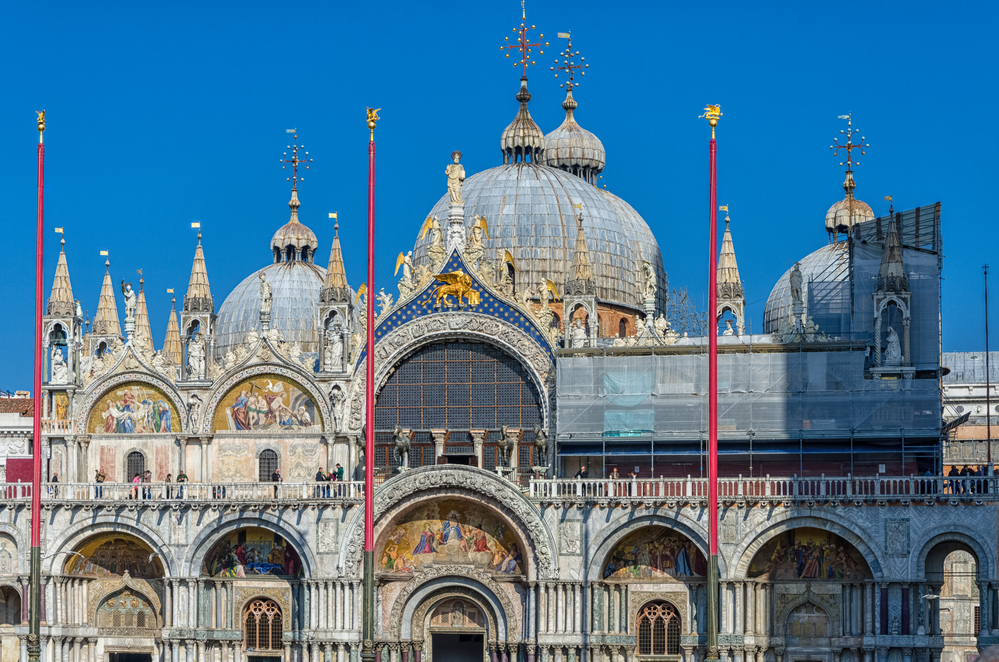
The existing structure dates from the eleventh century; however, it has undergone renovations and modifications. The current Basilica features five domes and is shaped like a Latin cross. In 1807, It gained cathedral standing.
It features 500 columns from the third century and about 4,000 square metres of mosaics, some dating from the thirteenth century. The Basilica’s nickname, “Chiesa d’Oro,” refers to the interior’s predominately gold colour (Golden Church).
Ascension Dome, the central dome of the ecclesiastical structure, is covered in mosaics from the early thirteenth century that show events from the New Testament. The mosaics in the church’s atrium are made of tiny glass tiles with gold leaves. These show scenes from the Old Testament.
Four marble and alabaster columns support the church’s high altar, which houses St. Mark’s relics. While the Basilica is generally accessible, several areas of the temple, including the museum, the treasury, and the Pala d’Oro, demand a ticket.
4) Palazzo Ducale
In Italian, Palazzo Ducale, the Doge’s Palace is located in Piazza San Marco. The walled castle, now known as the Palazzo Ducale, was built during the tenth and the eleventh centuries. The Piazza San Marco and the palace, which had suffered extensive fire damage, were reconstructed between 1172 and 1178. The Palazzo served as a garrison and jail during this time.
Byzantine, Gothic, and Renaissance architectural elements are mixed throughout the construction. Paintings by well-known Italian artists, including Titian, Tintoretto, and Bellini, are shown in this beautiful structure.
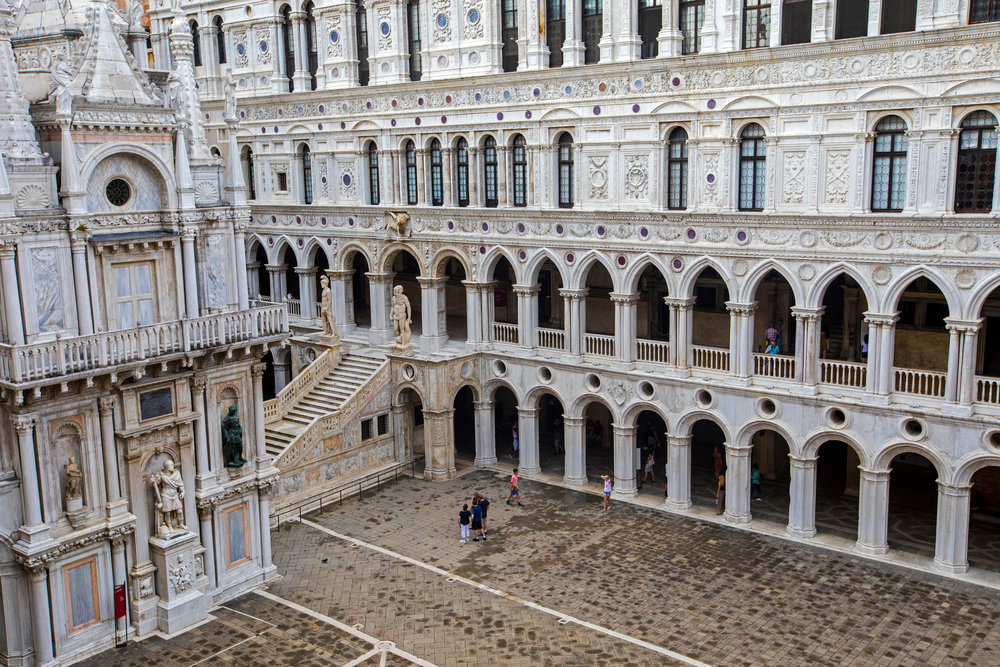
The Doges have resided and conducted business in the mediaeval castle since its erection in 810. From the Doge’s Palace, 120 doges ruled over Venice for almost a thousand years.
The Scala d’Oro, or majestic golden staircase, welcomes guests and leads to the second floor. The visitor will tour the Doge’s Apartments, the courtyard, the institutional chambers, the armoury, and the jails within the Palazzo.
Veronese, Titian, and Tintoretto paintings that reflect the city’s history are used to adorn the Doge’s Apartments. During your visit, you should head to the Maggior Consiglio hall, where over a thousand people would gather to vote on the Serenissima’s future. Tintoretto’s giant picture of the world, “Paradise,” is located in this room. The armoury is home to a sizable collection of armour and weaponry from many eras.
The tour concludes in the dungeons, where you can view the prisoner cells and humid wells (Pozzi) and get a sense of how miserable the conditions were back then. Giacomo Casanova, a well-known Venetian lover, was the only man to scale the palace’s roof in 1756 and escape the Doge’s Palace’s prison.
During the trip, you will cross the famous Bridge of Sighs. The baroque overpass was constructed in the seventeenth century to access the Palazzo’s jails. The melancholy moniker derives from the final time the men sentenced to death would cross the Bridge and gaze over the Lagoon.
A peculiar letterbox from a lion’s head called the Bocca di Leone served as a place for people to leave notes and report other Venetians who had committed crimes.
5) Rialto Bridge
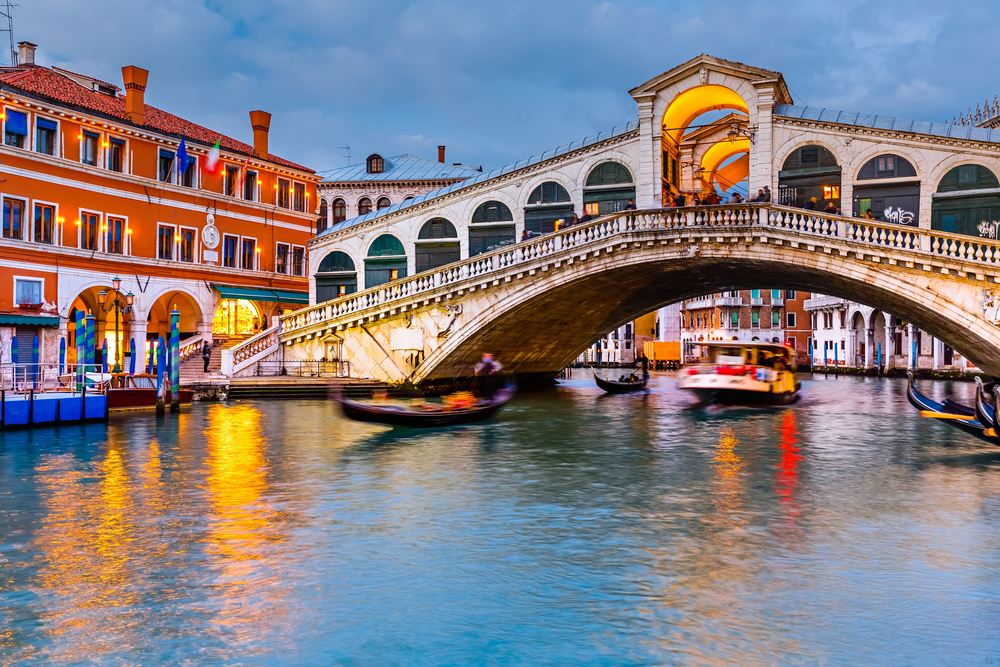
The Rialto Bridge is the oldest of the four bridges that span Venice’s Grand Canal. Due to its unique history and style, it is also the most well-known construction in Venice. The overpass served as Venice’s primary financial hub for a long time.
In place of a wooden bridge that had twice collapsed and been partially burned in 1310, Antonio da Ponte constructed the current Ponte di Rialto in stone between 1588 and 1591. The stone bridge has a similar layout to its forerunners, with two sloping ramps joined in the middle by an arch.
The Rialto Bridge is open for visitors at any time. We even suggest stopping by the bridge several times to appreciate the Grand Canal and, like the rest of the crowd on the Bridge, attempt to capture images of the characteristic Venice below.
Best Restaurants in Venice
The perfect Venice experience requires the perfect food experience. To save you some time, we have listed below the best restaurants in Venice that, hopefully, will make you come back to the city.
1) Osteria Campo Santa Marina
The original Osteria Campo Santa Marina was a little sandwich business. It currently ranks among the city’s most cutting-edge dining options. Agostino Doria, the chef, has spent the past 30 years perfecting his menu to honour traditional Venetian dishes while elevating them to a level of art.
Expect plenty of outdoor seating during the warmer months, but do not be shocked if customers stay inside, where the ambience is cosy, warmly lit, and always busy.
The restaurant specialises in serving raw fish, such as scallops carpaccio with shavings of smoked goose foie gras and sweet white wine jelly, but the house-made pasta is delicious as one could anticipate.
2) Quadri
Philippe Starck, a designer and architect, recently gave this most well-known restaurant in Venice, a landmark since 1830, a facelift. The restaurant’s famed Murano glass chandeliers cast a warm glow on the walls covered in inventive and whimsical fabric made by regional textile artisans.
A visit would be worthwhile just to see these lavish dining rooms that look out onto St. Mark’s Square, but the three- or five-course tasting menus inspired by the season are the real draw.
For instance, the accompanying beetroot foam, asparagus, and green pepper risotto taste like the start of spring. Generous amuse-bouches are mouth-watering and delectable as well. One of the few Venice menus to offer gluten-free options is this one.
3) Venissa
The trip to Mazzorbo Island in the northern Lagoon makes up half of the Venissa adventure. Since this is where Venice started, owner Matteo Bisol is infusing the restaurant with the spirit of his hometown of Venice.
When ordering the tasting menu, which you may modify to include five, eight, or ten plates, you will savour dishes like smoked eel, beetroot, kombucha, and sorrel or turbot with potatoes, porcini mushrooms, black summer truffle, and bay leaves.
Enjoy the restaurant’s vegetable gardens and vineyards while dining al fresco. Dine at the more relaxed but no less delicious Venissa Osteria Contemporanea during the winter when the main restaurant is closed.
Top-Rated Hotels in Venice
Have you ever had a dream of having breakfast in a fancy hotel with a charming view while listening to your favourite song? Well, Venice’s hotels can make this dream—and others—come true!
1) Hotel Bonvecchiati
The Hotel Bonvecchiati of Venice, which has its water landing for gondolas and water taxis, is a two-minute walk from Saint Mark’s Square and the Rialto Bridge. Each room is uniquely decorated in a traditional or contemporary Venetian style.
Each room features air conditioning, satellite T.V., and free WiFi. Views of the canal or the nearby roofs can be seen from some rooms. There is a buffet for breakfast. Venetian, traditional Italian, and ethnic cuisine are all provided at the waterfront terrace restaurant, La Terrazza. A large selection of wines from the on-site wine cellar is served with meals.
Fresh flowers are used as decoration all over this four-star hotel. The crew is available around-the-clock and is fluent in English. The distance to the Venezia Santa Lucia Train Station is 2 kilometres.
2) B.W. Premier Collection CHC Continental
On the Grand Canal, the B.W. Premier Collection CHC Continental is housed in a historic edifice dating back to the 15th century. It offers stunning views and a convenient position two minutes walk from Santa Lucia Train Station.
This hotel provides a Special Protection Program, a stringent set of specific measures devoted to both workers and visitors. The rooms have parquet flooring, lovely furnishings, air conditioning and satellite T.V. Many rooms, alongside the on-site restaurant, come with a terrific view of the Grand Canal.
A hot and cold buffet breakfast is available each morning. In the evenings, a wide range of wines is available with international cuisine and Venetian specialities.
3) Hotel Carlton on The Grand Canal
The Hotel Carlton in Venice offers expansive, Venetian-style rooms and a rooftop cocktail bar with a patio. Both the Piazzale Roma parking lot and the Santa Lucia train station are a 5-minute walk away.
The exquisite décor of this 4-star hotel for lovers features Murano glass lights and old-fashioned furniture. Every morning, There is a choice of an American breakfast; throughout the day, drinks and snacks are available in the Bar Carlton Café. The restaurant La Cupola offers both Italian and foreign cuisine.
The visitor has free access to the Venice Casino from Hotel Carlton on The Grand Canal. Restaurant and theatre reservations can be made at the front desk. A lovely 25-minute walk will take you to San Marco Square, also accessible by Vaporetto water bus.
4) Palazzo Veneziano
In Venice, the Palazzo Veneziano provides opulent apartments with free WiFi close to the S. Basilio boat terminal. The on-site bar is open to visitors. The property is located 1.8 kilometres from St. Mark’s Square and the Basilica.
The air-conditioned rooms of Palazzo Veneziano have parquet floors and marble baths. Some accommodations have spa baths. A few accommodations have canal views.
La Fenice Theatre is 1.5 km away, while Rialto Bridge is 2 km away from Palazzo Veneziano. The property is located 1.4 kilometres from Venezia Santa Lucia Train Station and 15 kilometres from Venice Marco Polo Airport.
5) Carnival Palace
New hotel Carnival Palace features ultra-modern rooms with wood floors and complimentary WiFi. It is so close to the Tre Archi Vaporetto water bus stop in the Jewish Ghetto neighbourhood of Venice. A full American breakfast is provided every morning; in the summer, you can enjoy your food outside in the garden.
Rome
Rome’s precise beginnings are still somewhat of a mystery. There are numerous ideas, all of which are based on the writings of historical authors and the information obtained from archaeological excavations.
As a result, rather than being founded on reliable facts and data, Rome primarily depends on mythology and myth. Expert historians even questioned the existence of the Roman Kingdom for nearly two centuries.
They rejected the notion of the early rulers of Rome (Romulus, Numa Pompilius, and Tullus Hostilius), as well as the date of the creation of what would eventually become the capital of Italy, which was 753 BC, during the nineteenth and twentieth centuries.
This section of history was only regarded as a myth and not given much weight. The tales surrounding the founding of the city and its first rulers were not reexamined until the late twentieth century, thanks to the results of several archaeological excavations and other disciplines.
The original people living in Rome are thought to have come from different parts of the territory. They did not have the same economic or cultural advancement as their northern neighbours, the Etruscans, or their southern counterparts, the Sabines and Latins.
Archaeologists discovered the ruins of a prehistoric town with burials on the periphery in Palatine Hill around the seventh century B.C. According to popular belief, as the population increased, the residents made their homes on the neighbouring hills’ slopes before settling in the valley throughout the following century.
Best Time to Visit Rome
Rome is a year-round tourist destination. However, we advise travelling in the spring or fall when there are typically fewer crowds of people. That being said, stay away from Rome around Easter when there are the most tourists.
Autumn has a higher probability of rain than spring. January and February are the two coldest months in Rome. Every few days, it rains over these two months, but some days can be pretty nice with highs of 12°C. At night, the temperature might fall below zero. Rome is stunning in winter.
The hottest month in Rome is July; however, August is not far behind, with average highs of 25°C. Visits to the city during these months may feel a little stuffy due to the excessive humidity. Many stores lock their doors in August, and many residents go on vacation.
Top Attractions in Rome
Discover the stunning squares, fountains, monuments, and sights of Rome. These top attractions in Rome make the city a breathtaking open-air museum.
1) Colosseum
Rome’s most iconic landmark is the Colosseum. It is a massive building with approximately two thousand years of history that will transport the visitor back in time to learn about Roman Empire life.
The Colosseum was built starting in the year 72 under Vespasian’s empire and was completed in the year 80 under Titus’ control. The Colosseum was the most significant Roman amphitheatre when it was finished, with dimensions of 156 metres in width, 188 metres in length, and 57 metres in height.
The Flavian Amphitheatre, formerly known as the Roman Colosseum, accommodated more than 50,000 spectators under the Roman Empire when the slogan was “Bread and Circuses.” The Roman populace was entertained for years by displays of exotic animals, executions of prisoners, recreations of battles, and gladiator contests.
Over 500 years passed while the Colosseum was in use. The sixth century saw the celebration of the last games known to history. The Colosseum has experienced looting; during the sixth century, there have been earthquakes and even bombings during World War II.
The Colosseum served for many years as a warehouse, church, cemetery, and even a castle for nobility, demonstrating a strong spirit of survival.
The Colosseum and the Vatican City are currently Rome’s top tourist destinations. Six million tourists go there annually. The Colosseum was included in the Seven Wonders of the Modern World list on 7 July 2007.
2) Roman Forum
Ancient Rome’s civic and religious activity centre was the Roman Forum. The Forum and the Colosseum are the two most prominent reminders of the grandeur of the Roman Empire that still exist today.
The Roman Forum was abandoned once the Roman Empire collapsed, and the ground gradually covered it. Even though the Forum’s existence and location were recognised in the 16th century, excavations did not begin until the 20th century.
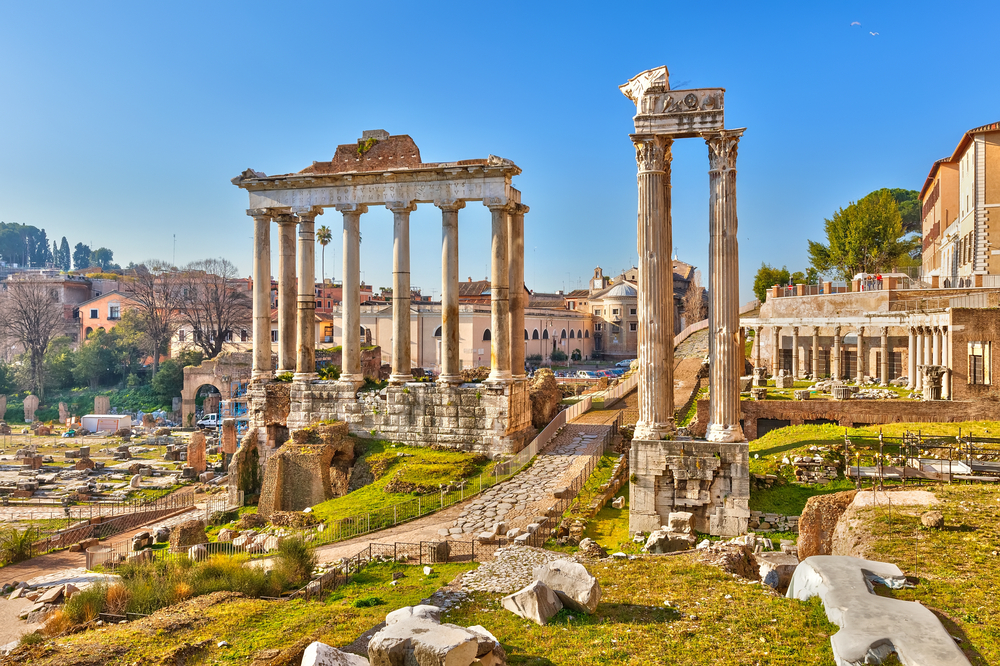
It is fascinating to know that the Forum’s current location used to be a marsh. The Cloaca Maxima, one of the first sewer systems in the world, was used to drain the area in the sixth century B.C. In addition to the numerous temples in the Forum, it is essential to pay close attention to the following sites:
1-Via Sacra: This was the principal thoroughfare in ancient Rome between the Colosseum and Piazza del Campidoglio.
2-Arch of Titus: This triumphal arch reminds us of Rome’s conquest of Jerusalem. It was constructed following the passing of Emperor Titus.
3-Basilica of Maxentius and Constantine: Despite being primarily demolished now, based on its scale, this likely was one of the most significant structures in the Roman Forum.
4-Temple of Antoninus and Faustina: Constructed in the second century, this monument stands out as the Roman Forum’s best-preserved temple.
5-The Curia: The Senate convened in this structure to discuss Roman administration matters and make administrative judgments.
It would be like travelling to Paris without viewing the Eiffel Tower to visiting Rome without exploring the Forum. Close your eyes and see the Via Sacra as it was more than 20 centuries ago when Julius Caesar walked along.
3) Piazza Navona
The Domitian Stadium (Circus Agonalis), established in 86 A.D., is where the public square now stands. It could accommodate about 20,000 spectators, who came to watch various athletic activities.
The Fontana dei Quattro Fiumi was built in the middle of Piazza Navona in 1651 and was designed by Bernini. The four statues stand in for the Nile, Danube, Ganges, and Rio de la Plata, four of the most significant rivers on the continents where Christianity had been practised.
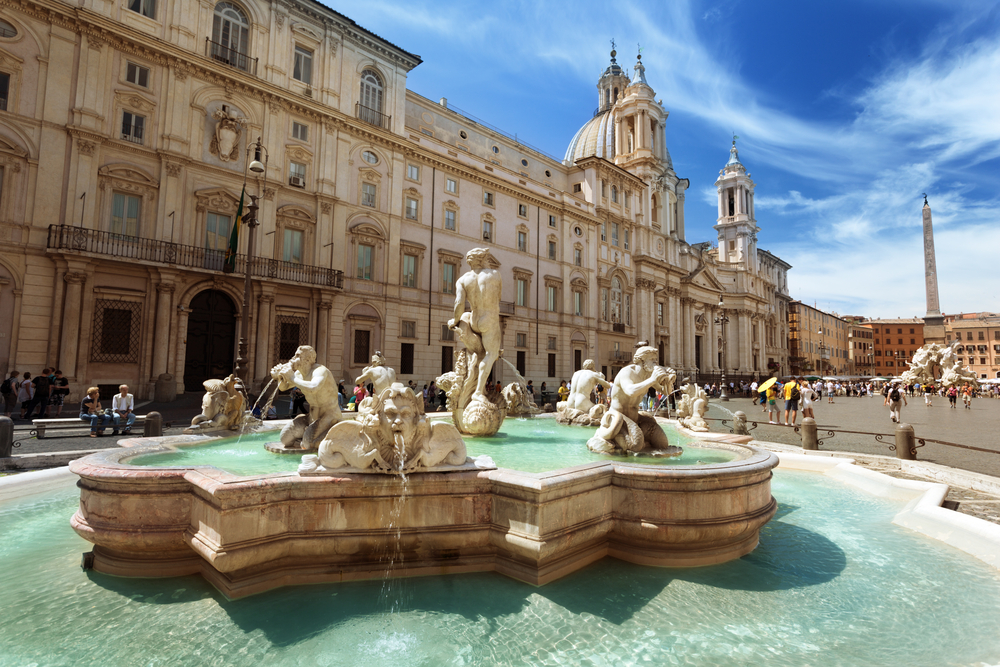
On the southern edge of the piazza, you will find another remarkable fountain. This fountain, previously known as the “Seashell Fountain,” was established by Giacomo della Porta and then improved by Bernini, who added the Moor figure.
Giacomo della Porta also began work on the Fontana del Nettuno (Fountain of Neptune) in 1574. However, Antonio Della Bitta completed it after that, and Gregorio Zappalà added the finishing touches in 1878.
Piazza Navona has restaurants and terraces, creating a bustling and delightful ambience during the day. Visitors can watch street performers, such as magicians and dancers, perform here. The Palazzo Pamphilj and the Church of Sant’Agnese in Agone are the two most prominent structures that front the Piazza.
4) St. Peter’s Square
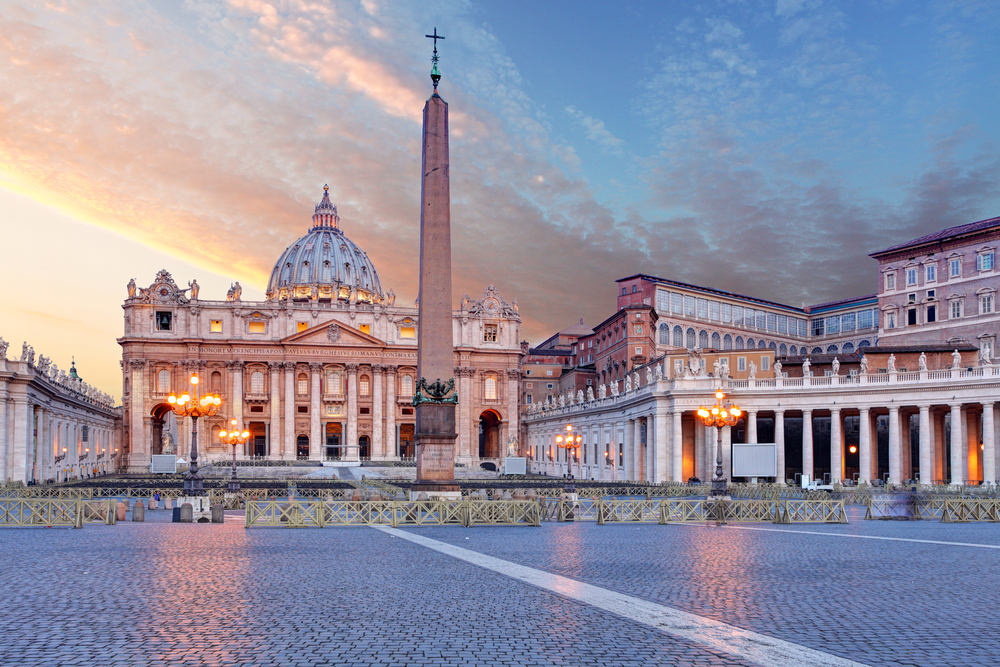
One of the most enormous and stunning squares on the entire globe is St. Peter’s Square. It is situated beneath St. Peter’s Basilica in Vatican City. The square is enormous, measuring 320 metres long and 240 metres broad. More than 300,000 people have gathered in St. Peter’s Square for liturgies and other notable occasions.
With the help of Pope Alexander XII, Bernini built the square between 1656 and 1667. Aside from its grandeur, the square’s 284 columns and 88 pilasters, which form an arcade with four rows, are its most striking feature.
One hundred forty saint statues were produced by Bernini’s students in 1670 and are displayed above the columns. The two fountains—one by Bernini (1675) and the other by Maderno—and the obelisk (1614) stand out in the middle of the square. The 25-metre-tall obelisk was transported from Egypt to Rome in 1586.
The Via della Conciliazione, a lengthy boulevard that starts in the Castel Sant’Angelo, is the most picturesque route one takes to go to St. Peter’s Square.
5) Pantheon
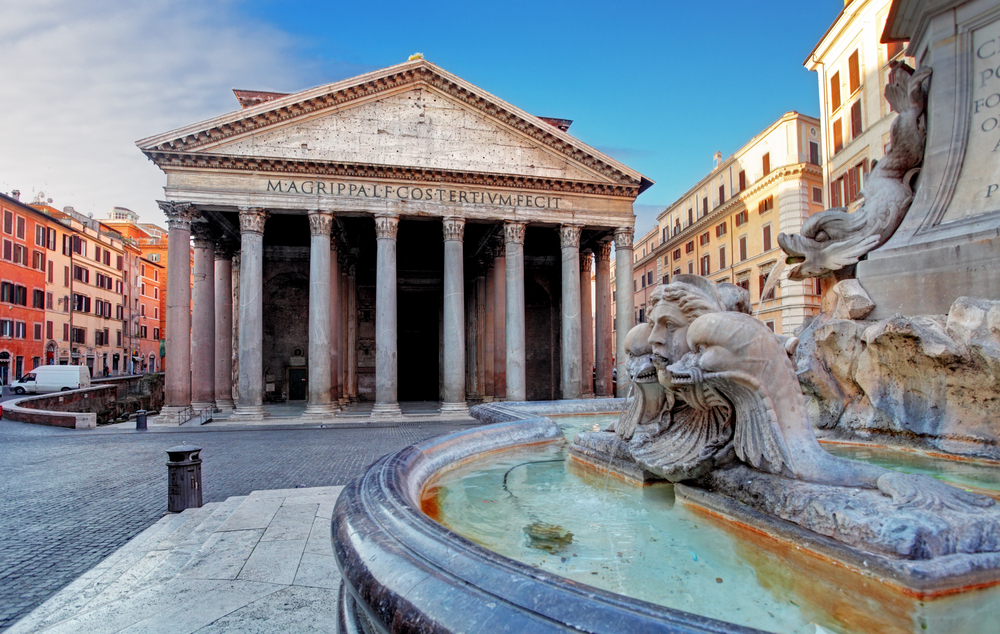
One of the city’s architectural wonders is the Agrippa Pantheon, also referred to as the Roman Pantheon. The Roman building is the one that has been preserved the best.
In the year 126 A.D., during the reign of Hadrian, work on the existing Pantheon was completed. The Pantheon of Agrippa, constructed in the year 27 B.C. and destroyed in a fire in the year 80 A.D., once stood where the new structure is now located, giving rise to the name of Agrippa.
The structure was given to Pope Boniface IV at the beginning of the seventh century, who converted it into a church, where it is still used today and is in pristine condition.
The Pantheon’s circular structure has the same circumference as its height: 43.5 metres. It is the most outstanding feature of the building’s design. The dome, which has the same diameter as St. Peter’s Basilica, is more prominent. A 9-metre diameter aperture at the top of the structure allows natural light to illuminate the entire building.
Marcus Agrippa, son of Lucius, constructed this temple. At the same time, he was a Consul, as evidenced by the 16 granite columns that make up the rectangular front that conceals the massive dome, each is 14 metres high and inscribed with the following words: “M.AGRIPPA.L.F.COS.TERTIVM.FECIT.”
Numerous Italian kings’ tombs and a vast array of artwork can be seen inside the Pantheon. Raphael, a painter and Renaissance architect, is undoubtedly the most well-known individual buried in the Pantheon.
The area around the Pantheon is typically crowded at all times, with tourists taking pictures of the impressive structure or enjoying a classic meal on one of the terraces of the Piazza della Rotonda while watching performances by various street performers.
Best Restaurants in Rome
Rome’s uniqueness is manifest on different levels. However, food is one thing that makes Rome particularly attractive to tourists. You will understand why food in Rome is such a big deal when you try eating in one of the following restaurants:
Felice e Testaccio
This restaurant is the undisputed highlight of Testaccio, which is often regarded as the best neighbourhood for Roman cuisine.
The vintage eatery, which features white tablecloths, classic checkered floors, and a mouthwatering selection of traditional foods, is ideal for a romantic meal for two or a relaxing weekend lunch with the family. Da Felice’s hallmark dish is cacio e pepe, a jumble of noodles, melted cheese, and black pepper that is freshly tossed.
Trattoria Monti
Trattoria Monti, one of Rome’s most trustworthy and delectable eateries, continues improving over time and is still a locals’ favourite. Its success can be attributed to its superb food, lovely atmosphere, and courteous service.
A comprehensive wine list with affordable markups is undoubtedly beneficial. There are plenty of vegetarian options, like giant tortillas with runny eggs and tarts with seasonal vegetables.
Seu Pizza Illuminati
Make reservations at everyone’s favourite pizzeria for these decadent Neapolitan pies. The eatery offers dozens of scrumptious pies, from traditional favourites like Margherita and marinara to more inventive varieties with toppings like purple cauliflower, smoked salmon, and pistachio crumbles.
Neon lights and a minimalist décor will appeal to all customers. Before diving into the main course, it’s recommended to start with the fritti, or fried starters.
Top-Rated Hotels in Rome
Waking up to an incredible view, the smell of a freshly made cup of coffee, and the sound of the Roman streets is what you need to enjoy your time in Rome to the max. It’s mind-blowing how Rome can provide both simultaneously: ancient, amazing monuments alongside modern, high-ranking hotels.
N.H. Collection Roma Fori Imperiali
The NH Collection Roma Fori Imperiali, which has a rooftop bar and restaurant with views of the Roman Forum and is in the centre of Rome, is open all day. The amenities of this establishment include free WiFi, room service, and a 24-hour front desk.
At N.H. Collection Roma Fori Imperiali, the rooms have a modern interior with teal, gold, and grey accents and wallpaper featuring Rome villas. They also have air conditioning. The Roman Forum may be seen from the majority of the rooms.
As a guest, you will be able to enjoy an à la carte breakfast every day. The breakfast menu includes pastries, cold cuts, cheese, yoghurt, fresh fruit, juice, and other delicacies. Natale Giunta restaurant serves traditional Roman and regional food at the Oro Bistrot.
Quirinale, Piazza Venezia, and Palazzo Venezia are popular attractions close to the hotel. Cavour Metro Station is located 1 kilometre from N.H. Collection Roma Fori Imperiali.
Horti 14 Borgo Trastevere
The busy neighbourhood of Trastevere is only a 10-minute walk from Horti 14 Borgo Trastevere, which is situated in the centre of Rome. The 4-star hotel has a nice bar and a courtyard.
The Horti 14 Borgo Trastevere offers contemporary, wholly furnished rooms with air conditioning and free WiFi. Every room comes with slippers, and some even have bathrobes.
The hotel is located 1 kilometre from Campo de’ Fiori and 15 minutes from Saint Peter’s Square and Vatican City. Roma Ciampino Airport and Roma Fiumicino Airport are the closest airports, 19 and 28 kilometres away.
H10 Palazzo Galla
H10 Palazzo Galla in Rome offers concierge services, allergy-free rooms, and free WiFi available throughout the building and in a common area. Piazza Venezia is within 200 metres of the hotel.
Visitors can stay at this hotel and use the terrace and family rooms. A front desk is open around-the-clock, and room service and luggage storage are available for visitors.
Palazzo Venezia, Quirinal Hill, and the Roman Forum are popular attractions close to the place. Rome Ciampino Airport is 14 kilometres from H10 Palazzo Galla, and the hotel provides a fee-based airport shuttle service.
Finally
Italy is frequently referred to as one big living museum with the most UNESCO World Heritage Sites of any nation. Its magnificent southern beaches, central Eternal City of Rome, and northern mountains make it one of the world’s most popular tourist attractions.
Italy has everything that makes a perfect holiday, including delicious food and wine, warm, sunny summers, and fantastic nightlife as a bonus.




